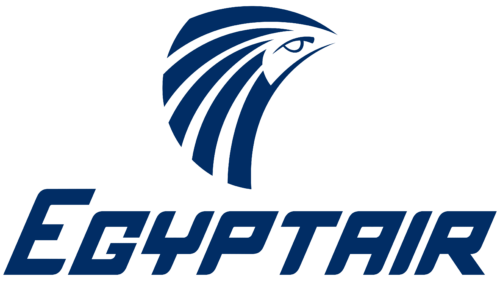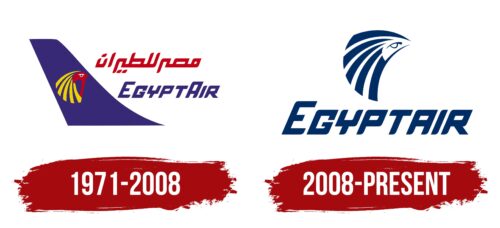The EgyptAir logo symbolizes an invitation to experience Egypt from the moment you board the plane. It goes beyond a mere journey between two points, introducing passengers to the rich tapestry of Egypt’s history, iconic pyramids, and delightful cuisine. This emblem suggests that travelers are in for a special experience, offering a preview of Egypt’s ancient wonders, from the pharaohs and hieroglyphics to the Nile River, all before even landing.
EgyptAir: Brand overview
The history of EgyptAir began on May 7, 1932, with the establishment of Misr Airwork by Egyptian industrialist Talaat Harb. Initially, the company focused on private transportation, agricultural, and geological survey services. The fleet consisted of small aircraft like the De Havilland DH.60 Moth and Gipsy Moth. By 1933, Misr Airwork started regular mail flights between Cairo and Alexandria using a De Havilland DH.84 Dragon aircraft, marking Egypt’s first regular air service. Over time, the route network expanded to include cities like Aswan, Luxor, and Port Said.
In 1935, the company was rebranded as Misr Airlines (Egyptian Airlines) and began international flights to Baghdad, Beirut, and Tel Aviv, using more advanced aircraft like the De Havilland DH.86 Express and Vickers VC.1 Viking. Operations were limited during World War II, but Misr Airlines resumed growth post-war.
In 1946, regular flights to London, Rome, and Athens were added, with the fleet now including American planes like the Douglas DC-3 and Lockheed Constellation.
In 1949, Misr Airlines was nationalized as Misrair, receiving significant government investment for economic development and international relations.
Throughout the 1950s and 1960s, Misrair expanded its network to Europe, Africa, and Asia, deploying jet aircraft like the De Havilland Comet, Vickers Viscount, and Boeing 707.
In 1960, the airline was renamed United Arab Airlines (UAA) to reflect the union with Syria, reverting to Egypt Airlines in 1971 and then EgyptAir.
The 1970s and 1980s saw EgyptAir continue its global expansion, adding routes to major cities like New York, Tokyo, and Beijing. The fleet grew with wide-body planes such as the Airbus A300 and Boeing 747, while partnerships with airlines like Air France and Lufthansa were established.
In 1985, a tragic incident occurred when a Boeing 737 was hijacked and exploded, resulting in 60 fatalities and prompting increased security measures. The company modernized its fleet in the following decades with Boeing 777 and Airbus A330 aircraft, opening new routes to cities like Toronto, Montreal, and Johannesburg. Joining the Star Alliance in 2008 further enhanced its global reach. The airline continued to evolve despite facing challenges like the 9/11 attacks and a downturn in air travel.
In 2002, a tragic crash in the Tunisian Gulf, caused by the pilot’s deliberate actions, claimed 14 lives. The airline persevered, focusing on fleet modernization and expanding its international network to overcome these obstacles. Despite facing various tragedies, the company continued to progress and evolve.
In 2004, the airline ordered 12 Boeing 737-800 and 7 Airbus A330-200 aircraft to update its fleet. By 2007, the company had reached a milestone by carrying its 30 millionth passenger since its inception. Throughout the 2010s, the airline focused on modernizing its fleet and expanding its route network.
The airline introduced new Boeing 787 Dreamliners and Airbus A320neo planes, improving fuel efficiency and passenger comfort. Additionally, the company opened new routes to Washington, Guangzhou, Tokyo, and Bangkok. A key achievement came in 2019 with the inauguration of a cutting-edge international terminal at Cairo Airport, which became the company’s primary hub. This state-of-the-art terminal, capable of accommodating up to 7.5 million passengers annually, was designed to reinforce Cairo’s status as a crucial transit point connecting Africa, the Middle East, and Europe.
The airline operates flights to over 75 destinations spanning 50 countries across Africa, Europe, the Middle East, Asia, and the Americas. With a modern fleet of approximately 70 aircraft, the company serves over 10 million passengers annually. As a proud member of the Star Alliance, the airline offers its passengers access to a vast global route network and upholds high service standards.
Meaning and History
What is EgyptAir?
Egypt’s national airline, based in Cairo, operates an extensive network of domestic and international flights, connecting Egypt to destinations in Africa, the Middle East, Europe, Asia, and the Americas. Known for its reliable service and modern fleet, it offers various classes of service, including economy, business, and first class. The airline is a member of Star Alliance and plays an important role in developing tourism and supporting Egypt’s economy.
1971 – 2008
From 1971 to 2008, EgyptAir utilized a distinctive branding symbol—the head of an Ibis on its aircraft’s tail. This image is not merely decorative; it carries a deep cultural and historical significance. The company’s name in Arabic, Marr leṭ-Tayarān, translates as the brilliance or reflection of a bird, directly linked to the image of the Ibis—a primary brand symbol.
In ancient Egyptian mythology, the Ibis is associated with Thoth, the god depicted as a man with the head of a bird. Thoth is revered as the guardian of wisdom and knowledge, and his figure symbolizes spiritual guidance and humanity’s desire to understand and master the world. The EgyptAir logo featuring the Ibis head represents human dominion, the pursuit of knowledge, and the divine essence, conveying the limitless potential of the human mind.
Thoth is one of Egypt’s most recognizable symbols, along with the pyramids. This image in the logo emphasizes the company’s origins and roots, embodying the country’s cultural heritage. The Ibis head recalls the Eagle of Saladin, a symbol of Arab nationalism depicted on the flag of Egypt, highlighting national identity and pride.
The choice of purple in the logo is intentional: it is associated with wisdom, the embodiment of aspirations, and the company’s global mission. This color underscores EgyptAir’s commitment to enabling people to fly, expanding horizons, and providing opportunities to explore the world, strengthening the brand’s connection with its historical and cultural roots.
2008 – today
The EgyptAir logo features the ancient Egyptian god Horus, symbolizing power and protection. Horus, the god of the sun and sky, is depicted with a falcon’s head and the pharaoh’s nemes headdress. Artists used expanding stripes to form the beak and nemes, integrating them into the design. The bird’s eye is styled like an ancient hieroglyph, adding cultural authenticity.
Below the image, “EgyptAir” is written in a unique font. All letters are capitalized, with the “E” being larger to draw attention. The use of Horus reflects Egypt’s rich heritage, conveying strength, wisdom, and regality, which builds trust in the airline.
The expanding stripes add a dynamic element, symbolizing the airline’s growth and influence. The hieroglyph-like eye ties back to ancient traditions, reinforcing the logo’s cultural significance. The unique font for “EgyptAir” emphasizes the airline’s individuality. The larger “E” enhances the design, making it memorable and impactful.






